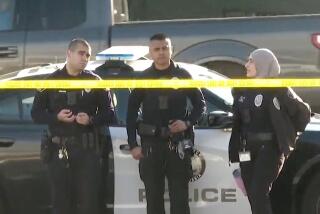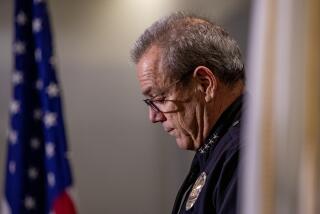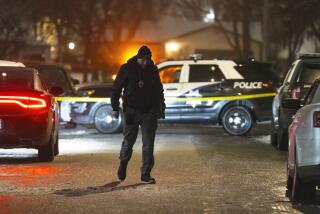Sheriff’s officer on scene of Laquan McDonald shooting never filed report
A Cook County sheriff’s officer was on the scene of Laquan McDonald’s fatal shooting by a Chicago police officer within a minute of the event, but he did not show up in police reports and was not part of any investigation until the FBI tracked him down months later, the Chicago Tribune has learned.
Sheriff Tom Dart’s office said Thursday that the officer and a second sheriff’s officer who arrived soon after were notified by Chicago police that they were not needed and left the scene. They never filed police reports about their involvement, Dart aide Cara Smith said.
Asked why the sheriff’s office’s involvement was never made public amid a yearlong investigation or during the recent uproar after video of the shooting was released and McDonald’s shooter was charged with murder, Smith said the office was not aware of its officers’ involvement until contacted by the Tribune on Wednesday night.
Smith confirmed that neither deputy filed a report with the sheriff’s department, although radio dispatch traffic released by the office suggests they were on the scene immediately after the controversial shooting. Smith said that when the FBI contacted the sheriff’s department in July seeking to interview the first sheriff’s officer on the scene, it did not say what investigation it was conducting.
The appearance of Cook County officers at the scene could be important, because the accounts of other police have been called into question. Chicago police who were present have all related similar stories that McDonald tried to attack police with a knife — a narrative that is not supported by video of his shooting that shows him moving away from Chicago officers when he was shot.
Chicago police Officer Jason Van Dyke, who is white, shot the black 17-year-old 16 times, with most of the shots coming after McDonald fell to the ground. Van Dyke was charged with murder two days before Thanksgiving by Cook County State’s Atty. Anita Alvarez.
Chicago police and the Independent Police Review Authority, which investigates Chicago Police Department shootings, never contacted either officer, Smith said.
The Tribune discovered the county officers were on the scene after viewing one of them standing among Chicago police officers in a segment of a CPD dashboard camera video, one of five DVDs of Chicago police video released by the city after the charges were filed.
The sheriff’s officer can been seen with several Chicago police officers just feet from McDonald, who appears to still be moving slightly. The time stamps on the videos from the five CPD vehicles appear to be in sync, and the time stamp on the video that captures the sheriff’s officer indicates he is there within one minute after McDonald was shot.
The sheriff’s officer can be seen pulling on blue plastic gloves and walking toward McDonald.
Smith said top sheriff’s department officials spoke to the officer Wednesday night after the Tribune raised questions. She said the officer provided a description of what he believed were the teen’s last moments.
McDonald was alive when the sheriff’s officer knelt down next to him, Smith said.
“He bent down and said, ‘Hang in there buddy,’” Smith said. She said the officer told his superiors Wednesday night that he heard “an audible exhale” and believed that McDonald died while he was kneeling next to the teen, and that no other police officers were close to him at the time.
Chicago police reports make no mention of any sheriff’s officers being on the scene. In their reports, Chicago police said a CPD officer kicked the knife away from McDonald’s hand after he stopped moving and told him, “Hang in there,” an ambulance was on the way.
The FBI contacted the sheriff’s office in July to interview the officer as a potential witness in the case, Smith confirmed. Asked how the sheriff’s department failed to realize it was then involved in the controversial case, Smith said the FBI said only that it was investigating a CPD incident from October 2014.
Additionally, the FBI requested and obtained the video camera system from the officer’s car in August, Smith said. But she added that Dart was not aware of that until his top aides began making inquiries late Wednesday following the Tribune call.
The video system, which was part of a “pilot program” testing cameras, was not working at the time of the Oct. 20, 2014, shooting, said Smith, Dart’s chief of policy and communications.
Smith said the first sheriff’s officer on the scene, Officer Adam Murphy, was assigned to a DUI enforcement detail patrolling an unincorporated area just northwest of Midway Airport that is not part of the city of Chicago. Murphy was not listening to Chicago police radio traffic but saw several Chicago police cars race by on Archer Avenue and joined in to help, Smith said.
Dispatch audio released by the sheriff’s office Thursday records his arrival on the scene of the McDonald shooting.
“I’m with a whole load of Chicago units. Looks like they had a shots fired, man down out here. I’m at 42nd and Pulaski,” he said over the radio.
The time stamp on the county’s audio recording is 9:57:53 p.m. McDonald’s shooting is time-stamped on Chicago police video at 9:57:36 p.m. It is not clear whether those systems are synchronized.
Smith said neither Murphy nor the second sheriff’s responder, Officer Jeff Pasqua, witnessed the shooting. Both men have been subpoenaed to testify in front of a federal grand jury investigating the shooting. Neither officer faced any administrative discipline over the incident, Smith said, because the sheriff’s office did not require any reports to be filed.
The two sheriff’s officers spent about 10 minutes on the scene before being informed by Chicago police that “the fire department ambulance was on the way and they needed no further assistance from our officers,” Smith said.
Twitter: @davidheinzmann
ALSO
A night of violence that shattered a South African’s view of her white privilege
Black scientists respond to Scalia’s suggestion that they took ‘less advanced’ classes
Ex-Oklahoma cop’s rape conviction a symbol of a national problem, investigation shows
More to Read
Start your day right
Sign up for Essential California for news, features and recommendations from the L.A. Times and beyond in your inbox six days a week.
You may occasionally receive promotional content from the Los Angeles Times.






